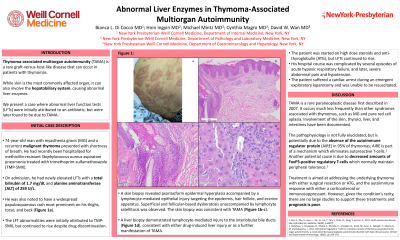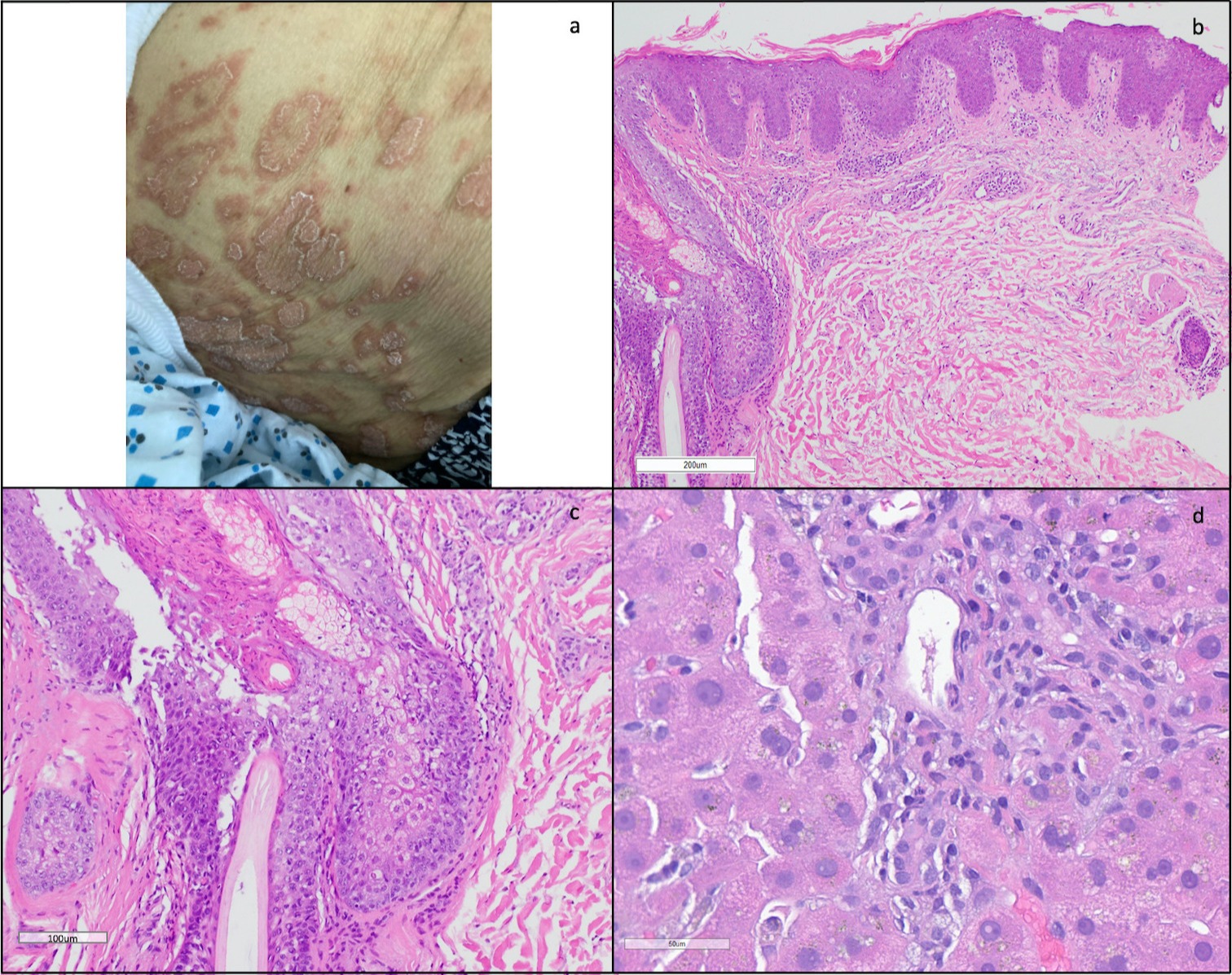Back


Poster Session E - Tuesday Afternoon
Category: Liver
E0540 - Abnormal Liver Enzymes in Thymoma-Associated Multiorgan Autoimmunity
Tuesday, October 25, 2022
3:00 PM – 5:00 PM ET
Location: Crown Ballroom

Has Audio

Bianca Di Cocco, MD
New York-Presbyterian/Weill Cornell Medical Center
New York, NY
Presenting Author(s)
Bianca Di Cocco, MD1, Hnin Ingyin, MD1, Michael J. Mintz, MD2, Cynthia Magro, MD1, David Wan, MD2
1New York-Presbyterian/Weill Cornell Medical Center, New York, NY; 2New York-Presbyterian Hospital/Weill Cornell Medicine, New York, NY
Introduction: Abnormal liver function tests (LFTs) are common in hospitalized patients, particularly in those treated with antibiotics. When due to medications, LFT abnormalities are typically transient and resolve with drug discontinuation. However, for patients with known thymomas and a new rash, rising LFTs can be a sign of thymoma-associated multiorgan autoimmunity (TAMA). We present a case where abnormal LFTs were initially attributed to an antibiotic, but were revealed to be TAMA based on skin and liver histopathological findings.
Case Description/Methods: A 74-year-old man with myasthenia gravis and a malignant thymoma presented with shortness of breath. He had recently been hospitalized for methicillin-resistant Staphylococcus aureus aspiration pneumonia treated with trimethoprim-sulfamethoxazole (TMP-SMX). On admission, he had newly elevated LFTs with a total bilirubin of 1.7 mg/dL and alanine aminotransferase (ALT) of 259 U/L. He also had a widespread papulosquamous rash (Figure 1a). The LFT abnormalities were initially attributed to TMP-SMX, but continued to rise despite drug discontinuation. Total bilirubin reached 28.4 mg/dL and ALT 698 U/L. A skin biopsy revealed psoriasiform epidermal hyperplasia accompanied by a lymphocyte-mediated epithelial injury targeting the epidermis, hair follicle and eccrine apparatus. Superficial and follicular-based dyskeratosis unaccompanied by lymphocyte satellitosis was observed. The skin biopsy was consistent with TAMA (Figure 1b-c). A liver biopsy was also performed which demonstrated lymphocyte-mediated injury to the interlobular bile ducts (Figure 1d), consistent with either drug-induced liver injury or as a further manifestation of TAMA. Following multidisciplinary discussion, the patient received antithyroglobulin (ATG) and dexamethasone for TAMA.
Discussion: TAMA is a rare graft-versus-host-like disease associated with thymomas. While skin is the most commonly affected organ, it can also involve the hepatobiliary and gastrointestinal systems. The pathophysiology is not fully elucidated, but is potentially due to the absence of the autoimmune regulator in thymomas that eliminates autoreactive T-cells, or due to decreased amounts of FoxP3-positive regulator T-cells. Treatment is aimed at addressing both the underlying thymoma with either surgical resection or ATG, and the autoimmune response with either a corticosteroid or immunosuppressant. However, given the condition’s rarity, there are no large studies to support these treatments and prognosis is poor.

Disclosures:
Bianca Di Cocco, MD1, Hnin Ingyin, MD1, Michael J. Mintz, MD2, Cynthia Magro, MD1, David Wan, MD2. E0540 - Abnormal Liver Enzymes in Thymoma-Associated Multiorgan Autoimmunity, ACG 2022 Annual Scientific Meeting Abstracts. Charlotte, NC: American College of Gastroenterology.
1New York-Presbyterian/Weill Cornell Medical Center, New York, NY; 2New York-Presbyterian Hospital/Weill Cornell Medicine, New York, NY
Introduction: Abnormal liver function tests (LFTs) are common in hospitalized patients, particularly in those treated with antibiotics. When due to medications, LFT abnormalities are typically transient and resolve with drug discontinuation. However, for patients with known thymomas and a new rash, rising LFTs can be a sign of thymoma-associated multiorgan autoimmunity (TAMA). We present a case where abnormal LFTs were initially attributed to an antibiotic, but were revealed to be TAMA based on skin and liver histopathological findings.
Case Description/Methods: A 74-year-old man with myasthenia gravis and a malignant thymoma presented with shortness of breath. He had recently been hospitalized for methicillin-resistant Staphylococcus aureus aspiration pneumonia treated with trimethoprim-sulfamethoxazole (TMP-SMX). On admission, he had newly elevated LFTs with a total bilirubin of 1.7 mg/dL and alanine aminotransferase (ALT) of 259 U/L. He also had a widespread papulosquamous rash (Figure 1a). The LFT abnormalities were initially attributed to TMP-SMX, but continued to rise despite drug discontinuation. Total bilirubin reached 28.4 mg/dL and ALT 698 U/L. A skin biopsy revealed psoriasiform epidermal hyperplasia accompanied by a lymphocyte-mediated epithelial injury targeting the epidermis, hair follicle and eccrine apparatus. Superficial and follicular-based dyskeratosis unaccompanied by lymphocyte satellitosis was observed. The skin biopsy was consistent with TAMA (Figure 1b-c). A liver biopsy was also performed which demonstrated lymphocyte-mediated injury to the interlobular bile ducts (Figure 1d), consistent with either drug-induced liver injury or as a further manifestation of TAMA. Following multidisciplinary discussion, the patient received antithyroglobulin (ATG) and dexamethasone for TAMA.
Discussion: TAMA is a rare graft-versus-host-like disease associated with thymomas. While skin is the most commonly affected organ, it can also involve the hepatobiliary and gastrointestinal systems. The pathophysiology is not fully elucidated, but is potentially due to the absence of the autoimmune regulator in thymomas that eliminates autoreactive T-cells, or due to decreased amounts of FoxP3-positive regulator T-cells. Treatment is aimed at addressing both the underlying thymoma with either surgical resection or ATG, and the autoimmune response with either a corticosteroid or immunosuppressant. However, given the condition’s rarity, there are no large studies to support these treatments and prognosis is poor.

Figure: A. Papulosquamous rash on patient's back. B. Skin biopsy with psoriasiform hyperplasia and interface dermatitis. C. Skin biopsy at higher power demonstrating follicular plugging by keratin and superficial clustered dyskeratosis without lymphocyte satellitosis. D. Liver biopsy with interlobular bile ducts surrounded and infiltrated by lymphocytes, monocytes, and a few neutrophils, reflective of a cellular type IV reaction targeting the bile duct epithelium with resultant cholestasis
Disclosures:
Bianca Di Cocco indicated no relevant financial relationships.
Hnin Ingyin indicated no relevant financial relationships.
Michael Mintz indicated no relevant financial relationships.
Cynthia Magro indicated no relevant financial relationships.
David Wan indicated no relevant financial relationships.
Bianca Di Cocco, MD1, Hnin Ingyin, MD1, Michael J. Mintz, MD2, Cynthia Magro, MD1, David Wan, MD2. E0540 - Abnormal Liver Enzymes in Thymoma-Associated Multiorgan Autoimmunity, ACG 2022 Annual Scientific Meeting Abstracts. Charlotte, NC: American College of Gastroenterology.

